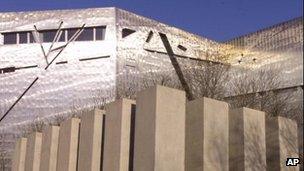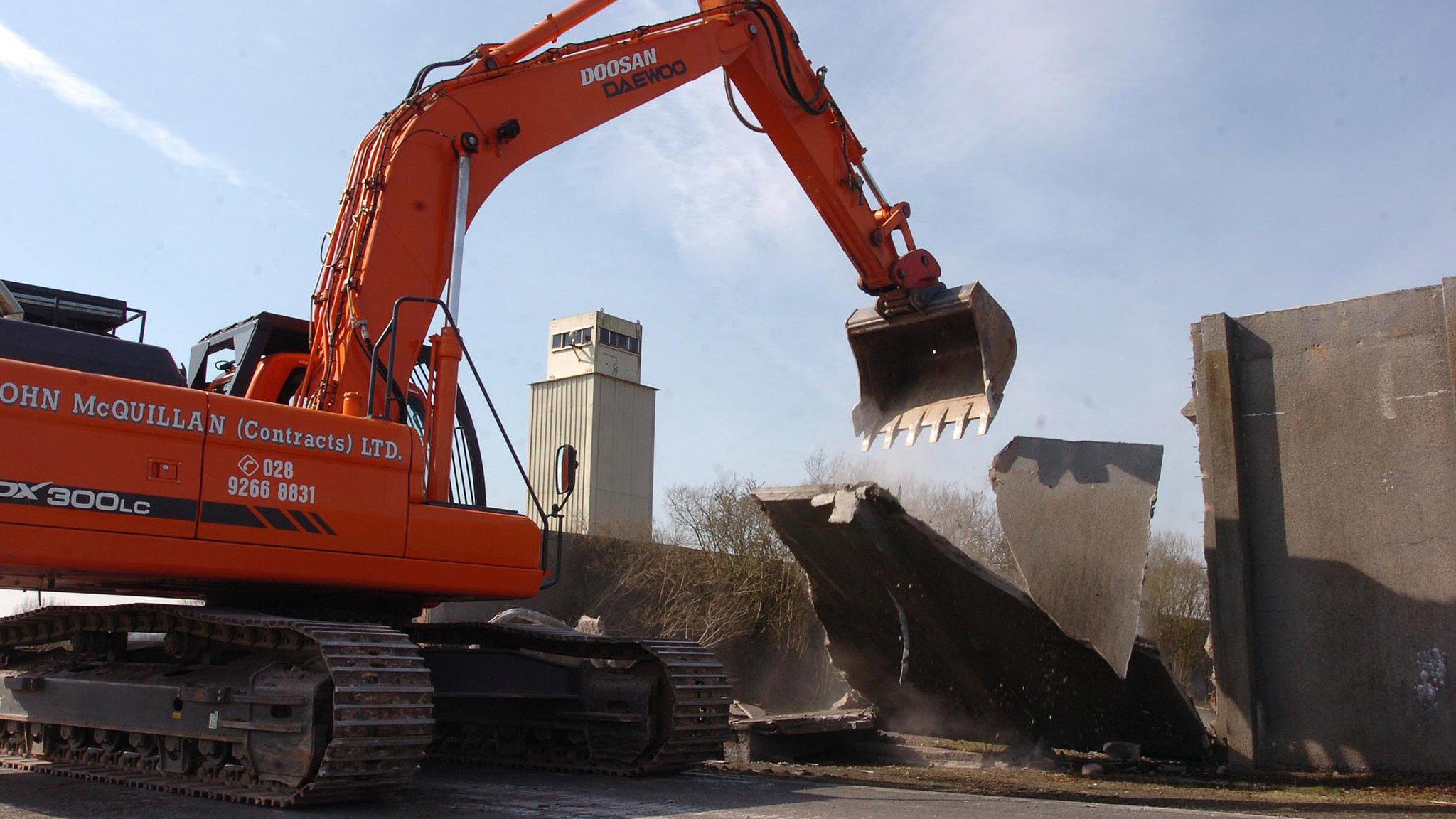Maze Prison redevelopment plans take shape
- Published
- comments

Daniel Libeskind and Terence Brannigan are key figures in the redevelopment of the Maze Prison site
Just like the proverbial London bus, you hang around waiting for an opportunity to get into the Maze jail, then two chances come along at once.
First on Monday, there was an interview with the new Maze Development Board chair, Terence Brannigan.
Then on Tuesday, I had a chance to meet the Ground Zero architect, Daniel Libeskind, who is working alongside local firm McAdam Design on the shape of a new Peace Building and Conflict Transformation Centre.
With the majority of the site now cleared, the 347 acres of the Maze look rather different from how they were before the jail shut 12 years ago.
But driving to the site, a few memories played through my mind:
There was the time when my cameraman and I had captured images of a rooftop protest from the bridge over the M1 motorway
I remember being taken inside in 1997 to inspect the damage caused to H block 6 by LVF prisoners in a dispute over visiting rights
And there was that wait in the car park for the first inmates released under the terms of the Good Friday Agreement to emerge through the turnstiles.
H6 is still standing, along with the prison chapel and hospital wing.
I didn't get the chance to tour the buildings this week, but my colleague Natalie Lindo documented what you can see there on this website last year.
Instead we surveyed the area in front of the prison remains where the new Peace Centre will stand.
Mr Libeskind told me he wanted to create a building which will provide hope, a place in which everyone can share.
Besides H6, the site also includes some of the old Nissen huts used to house internees.
These are likely to be moved closer to the other prison buildings.
Given his track record at places like Ground Zero and the Jewish Museum in Berlin, Mr Libeskind and McAdam Design will no doubt provide a thought-provoking structure (the Peace Building centre is due for completion in three years' time).
'IRA shrine'
But how the story of the jail and the wider troubles is told within its walls is bound to prove contentious.
Victims campaigner Willie Frazer has been quick to publicise a march in opposition to an "IRA shrine".
TUV leader Jim Allister didn't like what he heard about prisoners being consulted over the project, arguing this would be tantamount to allowing al-Qaeda to have its input into the content of New York's Ground Zero memorials.
The man charged with walking this political tightrope is Glentoran FC chairman Terence Brannigan, who makes the point that all manner of interested parties, including prison officers, victims, survivors and local residents, will be consulted.
He says the first and deputy first ministers will have the final say on the story told at the Peace Centre (something which may reassure both DUP and Sinn Fein grassroots, but not necessarily their Stormont opponents).
Both Mr Brannigan and First Minister Peter Robinson are adamant the Peace Centre will be no IRA shrine.

Daniel Libeskind's projects include the Jewish Museum in Berlin
Mr Brannigan got an early taste of the sensitivities involved when Sinn Fein officials got into a minor flurry of excitement over his DUP membership.
The Maze chair said he had not ticked the political activity box on his application form because, although he was a DUP member, he hadn't engaged in canvassing or any of the activities he'd been asked about.
After an hour or so, the Deputy First Minister Martin McGuinness killed the story by blaming reporters for getting energised about the matter.
This was a bit rich, as Sinn Fein officials had raised it with the media in the first place, but the party obviously then decided there was no point disrupting a project they want to move ahead.
After talking to Daniel Libeskind, I took a few moments to duck into the Ulster Aviation Society's Maze hanger, which as Will Leitch reported earlier this year, is a hidden gem.
The Maze Development Board want to start holding events on site on a regular basis and if the public get more of a chance to see the Society's impressive aircraft collection that can only be a good thing.
Finally, a fact I didn't know about Daniel Libeskind when I first reported his involvement with the Maze last month.
When he was growing up in Poland he was a celebrated child prodigy on the accordion, eventually playing alongside the great violinist Itzhak Perlman, external.
Mr Libeskind told the New York Times, external he "exhausted" the accordion and stumbled into architecture via an interest in mathematics and painting.
Given that both loyalists and republicans are partial to accordion bands, my tip to the architect is that if he wants the focus groups on his sensitive project to be harmonious, he should bring his accordion with him on his next visit.
- Published11 September 2012

- Published10 September 2012

- Published28 August 2012

- Published24 August 2012
